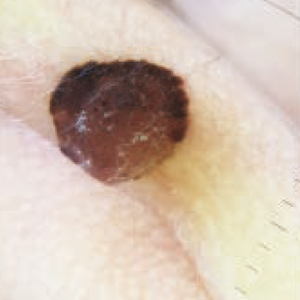Pediatric spitzoid lesions of the ear: a single-center experience and review of the literature

Accepted: 3 April 2023
HTML: 7
All claims expressed in this article are solely those of the authors and do not necessarily represent those of their affiliated organizations, or those of the publisher, the editors and the reviewers. Any product that may be evaluated in this article or claim that may be made by its manufacturer is not guaranteed or endorsed by the publisher.
Spitzoid lesions are challenging melanocytic lesions comprising benign, intermediate, and malignant lesions. In this study, we aimed to analyze the diagnostic accuracy of clinical and dermatoscopical evaluations of pediatric spitzoid ear lesions. We collected and analyzed, clinically, dermatoscopically, and histologically, pediatric spitzoid ear lesions. We also conducted a systematic review of the literature. At the Pediatric Hospital Gaslini, excision and histopathological evaluation were performed on eight cases: 87.5% of the lesions were consistent with Spitz nevus (SN), and 12.5% with atypical Spitz tumor (AST). Notably, multiple (≥2) dermatoscopical irregularities were present in 5 of 7 SN (71%), yet none were found in AST (0%, 0/1) (Fisher’s exact test, P=0.375). From systematic research in the literature, 9 patients were included in this review. At histology, 88.9% were SN and 11% AST. Remarkably, also in the literature, multiple dermatoscopical irregularities were present in most SN (75%, 6/8), but not in the identified AST (0%, 0/1) (P=0.3333). We present a monocentric study on pediatric spitzoid ear lesions. Importantly, dermatoscopical irregularities were not significantly associated with AST, neither in our series nor in the reviewed literature (respectively P=0.375 and P=0.3333), supporting the fact that relying only on the dermatoscopical aspect of spitzoid lesions is not accurate enough for the special site of the ear, where dermatoscopy could actually be misleading.
Busam KJ, Kutzner H, Cerroni L, Wiesner T. Clinical and pathologic findings of Spitz nevi and atypical Spitz tumors with ALK fusions. Am J Surg Pathol 2014;38:925-933. DOI: https://doi.org/10.1097/PAS.0000000000000187
Yeh I, Busam KJ. Spitz melanocytic tumours - a review. Histopathology 2022;80:122-134. DOI: https://doi.org/10.1111/his.14583
Frischhut N, Zelger B, Andre F, Zelger BG. The spectrum of melanocytic nevi and their clinical implications [published correction appears in J Dtsch Dermatol Ges 2022;20:1054]. J Dtsch Dermatol Ges 2022;20:483-504. DOI: https://doi.org/10.1111/ddg.14776
Vaccaro M, Marafioti I, Giuffrida R et al. Clinical and dermoscopic characterization of pediatric Spitz nevi of the ear. Pediatr Dermatol 2021;38:895-8. DOI: https://doi.org/10.1111/pde.14616
Page MJ, McKenzie JE, Bossuyt PM, et al. The PRISMA 2020 statement: an updated guideline for reporting systematic reviews. Systematic Reviews 2021;10:89 DOI: https://doi.org/10.1186/s13643-021-01626-4
Ferrara G, Cavicchini S, Corradin MT. Hypopigmented atypical Spitzoid neoplasms (atypical Spitz nevi, atypical Spitz tumors, Spitzoid melanoma): a clinicopathological update. Dermatol Pract Concept 2015;5:45-52. DOI: https://doi.org/10.5826/dpc.0501a06
Liang Y, Yu Y, Luan W, Xu J. "Red Spitz Tumor" on the Ear: Case Report and Review of the Literature. Clin Cosmet Investig Dermatol 2022;15:339-45. DOI: https://doi.org/10.2147/CCID.S349749
Ikeda A, Goto H, Sugita K, Yamamoto O. Congenital Nodule on the Ear in a Two-year-old Boy: A Quiz. Acta Derm Venereol 2018;98:993-4. DOI: https://doi.org/10.2340/00015555-3022
Lallas A, Apalla Z, Ioannides D, Lazaridou E, Kyrgidis A, Broganelli P, Alfano R, Zalaudek I, Argenziano G; International Dermoscopy Society. Update on dermoscopy of Spitz/Reed naevi and management guidelines by the International Dermoscopy Society. Br J Dermatol. 2017;177:645-55. DOI: https://doi.org/10.1111/bjd.15339
Lallas A, Apalla Z, Papageorgiou C, Evangelou G, Ioannides D, Argenziano G. Management of Flat Pigmented Spitz and Reed Nevi in Children. JAMA Dermatol. 2018;154:1353-4. DOI: https://doi.org/10.1001/jamadermatol.2018.3013
Davies OMT, Majerowski J, Segura A, Kelley SW, Sokumbi O, Humphrey SR. A sixteen-year single-center retrospective chart review of Spitz nevi and spitzoid neoplasms in pediatric patients. Pediatr Dermatol. 2020;37:1073-82. DOI: https://doi.org/10.1111/pde.14320
Bartenstein DW, Fisher JM, Stamoulis C, Weldon C, Huang JT, Gellis SE, Liang MG, Schmidt B, Hawryluk EB. Clinical features and outcomes of spitzoid proliferations in children and adolescents. Br J Dermatol. 2019;181:366-72. DOI: https://doi.org/10.1111/bjd.17450
De Giorgi V, Venturi F, Silvestri F, Trane L, Savarese I, Scarfì F, Cencetti F, Pecenco S, Tramontana M, Maio V, Zuccaro B, Colombo J, Bagnoni G, Stingeni L, Massi D. Atypical Spitz tumours: an epidemiological, clinical and dermoscopic multicentre study with 16 years of follow-up. Clin Exp Dermatol. 2022;47:1464-71. DOI: https://doi.org/10.1111/ced.15123
Dika E, Ravaioli GM, Fanti PA, Neri I, Patrizi A. Spitz Nevi and Other Spitzoid Neoplasms in Children: Overview of Incidence Data and Diagnostic Criteria. Pediatr Dermatol. 2017;34:25-32. DOI: https://doi.org/10.1111/pde.13025
Dika E, Neri I, Fanti PA, et al. Spitz nevi: diverse clinical, dermatoscopic and histopathological features in childhood. J Dtsch Dermatol Ges 2017;15:70-5. DOI: https://doi.org/10.1111/ddg.12904
Merkel EA, Mohan LS, Shi K, et al. Paediatric melanoma: clinical update, genetic basis, and advances in diagnosis. Lancet Child Adolesc Health 2019;3:646-54. DOI: https://doi.org/10.1016/S2352-4642(19)30116-6
Afanasiev OK, Tu JH, Chu DH, Swetter SM. Characteristics of melanoma in white and nonwhite children, adolescents, and young adults: Analysis of a pediatric melanoma institutional registry, 1995-2018. Pediatr Dermatol. 2019;36:448-54. doi: 10.1111/pde.13836. DOI: https://doi.org/10.1111/pde.13836
Copyright (c) 2023 the Author(s)

This work is licensed under a Creative Commons Attribution-NonCommercial 4.0 International License.
PAGEPress has chosen to apply the Creative Commons Attribution NonCommercial 4.0 International License (CC BY-NC 4.0) to all manuscripts to be published.





 https://doi.org/10.4081/dr.2023.9642
https://doi.org/10.4081/dr.2023.9642



